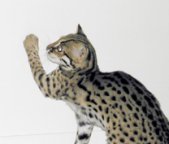













Length: 89 to 96 cm (35 to 38 in) Weight: 3 to 7 kg (6 to 15 pounds)
The most common cat of southern Asia, the leopard cat is a small spotted cat about the size of a domestic cat, but rather longer legs than the domestic cat. Their coloration is diversified throughout their range, from pale tawny, to yellow, red or gray on the upper part of the body with the under parts being white and spotted all over. Black or dark brown spots or rosettes cover the sides of the body, with solid spots running down the legs and the tail. There are usually four dark stripes running down the forehead to the nape of the neck, breaking up into short bands and elongated spots on the shoulders. Often there is one stripe running the length of the body. The length of the fur also differs according to their range, with those cats in the northern part having the longer, thicker coats than the southern counterparts or subspecies. The relatively small head has a short, narrow muzzle, a white chin, and two narrow black check stripes enclosing a white area. Two white and four dark stripes run up from the inner corners of the eyes towards the ears. The irises are a deep, golden brown to grayish color. The long rounded ears are dark on the outside, with a white central spot. The tail is spotted above with a few indistinct spotted rings near the buff colored tip.
These cats are primarily nocturnal, and hunt both on the ground and in the trees. Like most wild cats, they swim well. Showing little aversion to human presence, the leopard cat can frequently be found close to villages, and has been kept to control rodents by the villagers, much like the geoffroy cat of South America. Most of their hunting is done at night, but they can be found in twilight, preying on rodents and other small mammals, birds, reptile, fish, and insects. Like most small cats they are vary agile but not to the degree as the geoffroy cat. These cats are known more for climbing than jumping.
After a gestation period of 65 to 70 days, one to four young are born. The normal is two or three kittens. Nests are usually in hollow trees, rocky crevices or burrows. The average weight of a kitten at birth is 80 grams and their eyes open around 10 to 12 days. Leopard cats from the northern part of their range appear to have a higher birth rate in May, but in the southern parts kittens have been found all year around. The sexual maturity in the wild is documented at 18 month. There appears to be no difference in maturity with the female and male.
The longevity of these cats is about the same as the domestic - 15 years in captivity. Those in the wild appear to have a much sorter life span. This can be attributed to the lifestyle, their location on the food chain, and the lack of vaccines.
The Asian Leopard cat and the Amur Leopard cat are the wild cats used to create the hybrid known as the "Bengal Cat". The variations in the Bengal cat come from the different leopard cats as well as the different domestic used in the hybrid process.
At this time we do have at least one litter of Asian Leopard Cats due. If interested in a kitten and it is legal in your state, county, and city, please contact us.
If you would like to contact us:Cocoa
Home (Home Index)
(Robert & Colette Griffiths)
Pictures are not to be copied